Content
Having its own piece of land, it is often used as a vegetable garden. And if the area of the site allows, then you can not only plant various types of vegetables, berries and fruits, but also diversify certain types of planting of different varieties. For example, tomatoes come in many varieties, some of which are ideal for canning as a whole, while others are suitable for fresh consumption. Choosing a variety for conservation, you can also plant large-fruited tomatoes. Large-fruited varieties include the Yellow giant tomato. Its fruits are not only large in size, but also quite sweet in taste.
Detailed description of the variety
The Yellow Giant tomato variety was bred by a group of breeders of the Sedek agricultural firm. The plant is indeterminate, the height of its bushes can reach up to 1.7 m, the lash does not end with a flower brush and can continue to grow. The bushes are dense, require pinching and timely garter to the support. The leaves are large, dark green, potato type. The bush can form 2 stems, while giving up to 10 inflorescences. Up to 6 fruits can be formed on one cluster.
Description of fruits
The impressive size of the fruits of the Yellow Giant variety significantly distinguishes it from other varieties of tomatoes. It belongs to the salad type. The fruits of this tomato are large, reaching an average of 400 g. The largest specimens were recorded when growing Claude Brown's Yellow Giant tomatoes weighing from 700 g to 1 kg.
The color of the fruits is yellow-orange, the shape is uneven, ribbed and flat-round. The pulp is fleshy, juicy enough. On a horizontal cut, a large number of small seed chambers are observed, which are filled with liquid and have practically no seeds.
The taste of tomatoes is rich, sweet, with a slight sourness. The peel is thin, easily cut through. The consistency of the pulp is pleasant.
Since the tomato of the Yellow Giant variety belongs to the salad type, it is recommended to use it fresh, for cutting into vegetable salads or for preparing various dishes.
Varietal characteristics
The Yellow Giant tomato variety is intended for planting in open ground, but it also takes root well in a greenhouse. The only difference between growing a Yellow Giant tomato variety in a greenhouse shelter is that the bush can be taller, and the fruits will begin to ripen a little earlier.
The yellow giant tomato belongs to mid-season varieties, from the moment of sprouting to the ripening of the first wave of the crop, 110-120 days pass. Long-term fruiting - up to 45 days, stable, does not depend on climatic conditions. Tomato takes root in almost all regions, except for the Far North. The highest yields are observed in regions with warm and sunny climates.
The approximate average yield in open ground from a bush is about 5.5 kg, and from 1 sq. m up to 15 kg.
Resistance to diseases is average, without protective and preventive treatments, bushes and crops can be susceptible to the following types of diseases:
- tobacco mosaic;
- late blight;
- alternaria;
- peronosporosis;
- cladosporiosis.
Among the pests, the Colorado potato beetle can be distinguished, which is especially dangerous for the seedlings of the Yellow Giant tomato variety. But in greenhouse conditions, the vulnerability of plants to aphids, whiteflies and thrips is observed.
Advantages and disadvantages
Like all garden plants, the Yellow Giant tomato has its own advantages and disadvantages.
Positive qualities include:
- high and long-term productivity;
- unpretentious cultivation;
- fruits are large, beautiful color and rich sweet taste;
- the presence of a large number of trace elements in the fruit, the Yellow Giant tomato variety is especially valued for the presence of niacin, carotene and lycopene in it;
- these fruits are absolutely safe, therefore they are allowed to be used as food for allergies and as baby food;
- the yellow color of the tomato indicates a lower degree of acidity, as well as a low calorie content;
- fresh consumption of yellow tomatoes helps to accelerate metabolism in the human body;
- cracking of fruits is minimal compared to other large-fruited varieties.
Despite the considerable number of positive properties of the Yellow Giant variety, it also has disadvantages:
- the size of the tomatoes makes them unsuitable for canning as a whole;
- a tall and dense bush takes up a lot of space, so a large area needs to be allocated for planting;
- fruits are not intended for long-term fresh storage, do not tolerate long-term transportation;
- poor resistance to diseases and pests.
Planting and care rules
According to the reviews of gardeners and a photo of the harvest, you can see that the Yellow Giant tomato does not have special rules for planting and leaving. The only thing to consider when planting seedlings is that the bushes are tall enough and have dense foliage.
Growing seedlings
Like many varieties of tomatoes, the Yellow Giant is recommended to be planted in open ground in a seedling way. Seedlings can be purchased or grown on their own. If you plan to grow seedlings yourself, then the seeds of the Yellow Giant tomato variety should be taken only from a trusted manufacturer, or you can prepare them from the last harvest. They are harvested only from the largest fruits, which are still fully ripe on the bush.
Seeds for seedlings must be sown 2 months before the expected date of planting in open ground. Before planting seeds, they must be soaked in a weak manganese solution with the addition of a growth stimulator. After soaking, the seeds are dried and placed in a refrigerator for 1-2 days for hardening.
Soil for seeds should consist of peat soil, humus (rotted manure) and turf. In this case, for every 10 kg, it is necessary to add 1 tsp. potassium sulfate, superphosphate and urea. The soil must be well mixed so that the components are evenly spaced.
Before sowing, the soil is moistened and furrows are made on its surface to a depth of 1 cm. Between the furrows it is necessary to make a distance of at least 6 cm, and between the seeds - 2-2.5 cm. Sow seeds and lightly sprinkle them with soil, watering is not required.
For the germination of tomato seeds of the Yellow Giant variety, a favorable temperature is 22-25 degrees. After the shoots have sprouted, after about 10-15 days, it is necessary to dive into more fertile soil, into separate pots.
Transplanting seedlings
The soil of the future yellow giant tomato beds needs to be prepared in the fall. The soil must be dug up and fertilized. Fertilize the soil in the fall with humus (rotted manure) per 1 sq. m 4 kg.
In the spring, it is also necessary to dig up the soil and add humus again - 4 kg per 1 sq. m, but already with the addition of 1 tbsp. l. superphosphate and potassium chloride.
Planting seedlings in open ground should be carried out from mid to late May. At this time, the seedlings should already be about 50-55 days old. But in greenhouse shelters, you can plant seedlings from the end of April.
Landing is performed in parallel rows or staggered.The distance in a row between seedlings should be 20-25 cm, and between rows - 60 cm.In a checkerboard planting scheme, a distance of up to 40 cm should be retreated between seedlings, and the row spacing should be 50 cm.
After planting, it is necessary to perform preventive spraying with a solution of copper oxychloride (1 tablespoon per 1 liter of water).
Follow-up care
Bushes need pinching for proper formation. It is necessary to form a bush of 2 stems to ensure a full harvest.
Watering is required as the soil dries up, after which it is advisable to loosen to saturate the soil with oxygen.
Top dressing for the entire period of growth and vegetation should be performed at least 3 times:
- The first top dressing is performed 2 weeks after planting seedlings in open ground. They are fed with a solution of 1 kg of manure with 10 liters of water.
- The second feeding is required after the fruit ovaries on the second brush. It is carried out exclusively at the root with a mixture of 1 kg of manure, 3 g of copper sulfate and 3 g of manganese per 10 liters of water.
- The third feeding is performed with the same solution as the second, during the ripening of the first wave of fruits.
After each top dressing, it is recommended to mulch with a mixture of soil with sawdust, fine straw or pine needles.
Conclusion
The Yellow Giant tomato is ideal for planting if you plan to use the crop fresh. Despite this, many housewives have learned how to preserve this variety of tomatoes, making hot sauces, tomato juices and various winter salads from them.
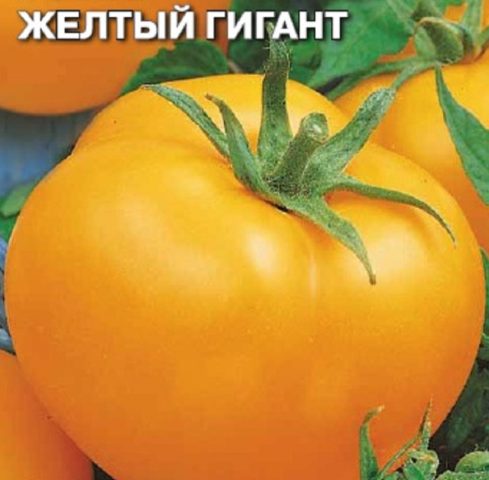
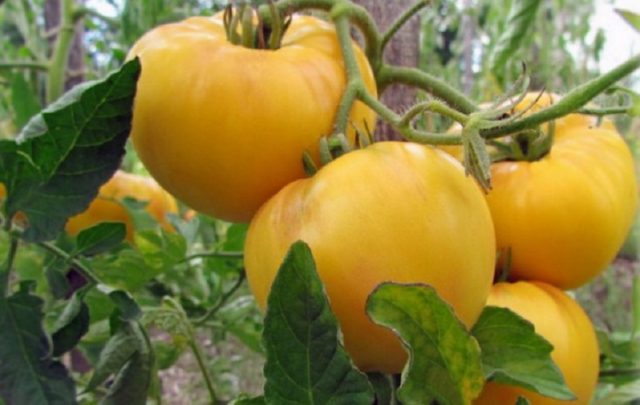
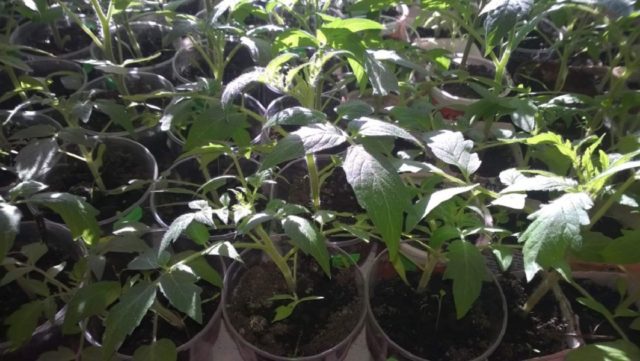


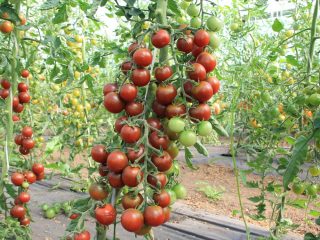
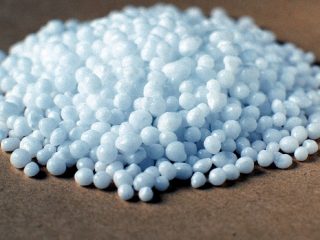

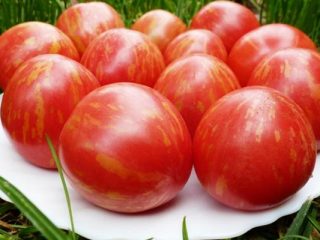


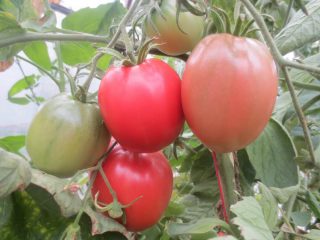
This type of tomato was planted for the first time last year. Indeed, it is a salad type, very tasty fresh, as well as in the form of tomato paste and seasoning. Sweet and juicy, the main thing is to use it when the fruits reach full maturity. And most importantly - excellent yield! Tomatoes are large, there are many of them on the bushes. The only caveat is that in a polycarbonate greenhouse, all the bushes of this variety got sick with brown spot. True, this did not affect the result. The fruits had time to ripen, part of the harvested crop ripened in boxes.